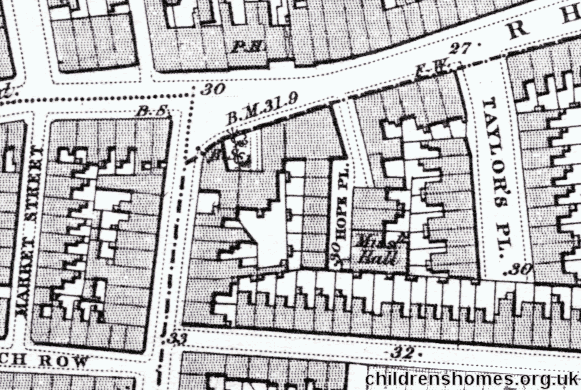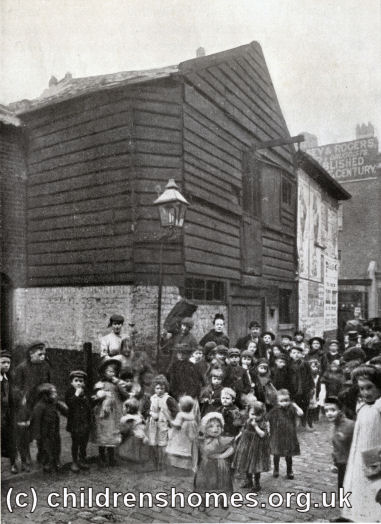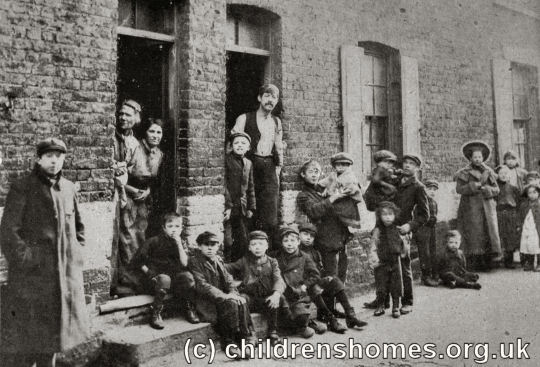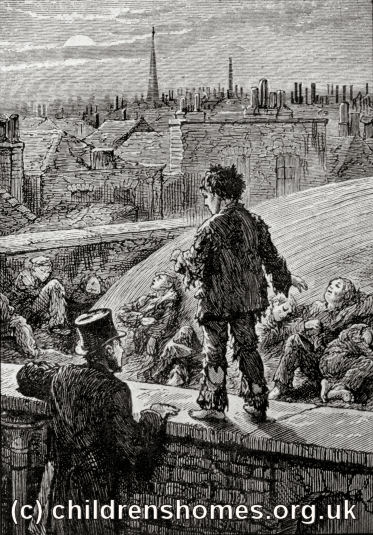Hope Place Ragged School, Limehouse, London
On March 2nd 1868, Thomas Barnardo opened his East End Juvenile Mission at Hope Place, Limehouse, London E14. Although the location of Hope Place is sometimes given as Bull Lane, it was actually off Rhodeswell Road, now Ben Jonson Road. Although Barnardo later liked to describe the property as a converted donkey stable, it was really a pair of adjoining cottages, one being used to accommodate boys and the other girls.

Hope Place area, Limehouse, 1873.
Hope Place was partly a 'ragged school' — a free school on Sundays for poor children in the area — and also the base for Barnardo's evangelical missionary work. Activities at Hope Place soon grew to include weekly services for children; bible classes for men, women and children; mothers' meetings; and girls' sewing classes; and a special service each evening which was attended by an average of 130 lads. Plans were also being developed for a day school and a self-financing 'refuge' or hostel for orphan working boys who would pay three shillings a week for board and lodging.

Hope Place, Limehouse. © Peter Higginbotham

Hope Place, Limehouse. © Peter Higginbotham
At around this time, Barnardo encountered a destitute boy named Jim Jarvis who was to have a profound effect on his work. Jarvis, a homeless orphan, revealed how he and hundreds of boys like him slept rough in London each night. You can read Barnardo's own account of the meeting.

Jim Jarvis shows Thomas Barnardo a rooftop 'lay' of destitute boys, c.1869. © Peter Higginbotham
The plight of destitute homeless children such as Jim Jarvis led Barnardo, in September 1870, to open his home for working lads at 18-20 Stepney Causeway.
In the meantime, the Hope Place premises expanded into neighbouring cottages and a makeshift hall to seat three hundred was created at the rear of the buildings by removing the garden walls and roofing over the area. Within a few years, though, the scale of Barnardo's activities outgrew the capacity of Hope Place, with a large new mission centre being established in 1872 at the Edinburgh Castle premises, and a much larger ragged school set up at Copperfield Road in 1875.
The Hope Place Mission closed in 1876. The site is now covered by the Solent House flats on Estate Road at the south side of Ben Johnson Road. A blue plaque (above what is currently a Chinese restaurant) commemorates Barnardo's work at Hope Place.
Records
Note: many repositories impose a closure period of up to 100 years for records identifying individuals. Before travelling a long distance, always check that the records you want to consult will be available.
- Barnardo's 'Making Connections' and Family History Services — for enquiries relating the records of children formerly in the care of Barnardo's and those of other organisations absorbed by them.
Bibliography
- Barnardo, Syrie Louise, and Marchant, James Memoirs of the Late Dr Barnardo (Hodder & Stoughton, 1907)
- Batt, J.H. Dr. Barnardo: The Foster-Father of "Nobody's Children" (S.W. Partridge, 1904)
- Bready, J. Wesley Doctor Barnardo (Allen & Unwin, 1930)
- Higginbotham, Peter Children's Homes: A History of Institutional Care for Britain's Young (2017, Pen & Sword)
- Rose, June For the Sake of the Children: Inside Dr. Barnardo's: 120 years of caring for children (Hodder & Stoughton, 1987)
- Wagner, Gillian Barnardo (Weidenfeld & Nicholson, 1979)
Links
- The Barnardo's website.
- The Goldonian Website — memories and information from former Barnardo's children.
Except where indicated, this page () © Peter Higginbotham. Contents may not be reproduced without permission.


